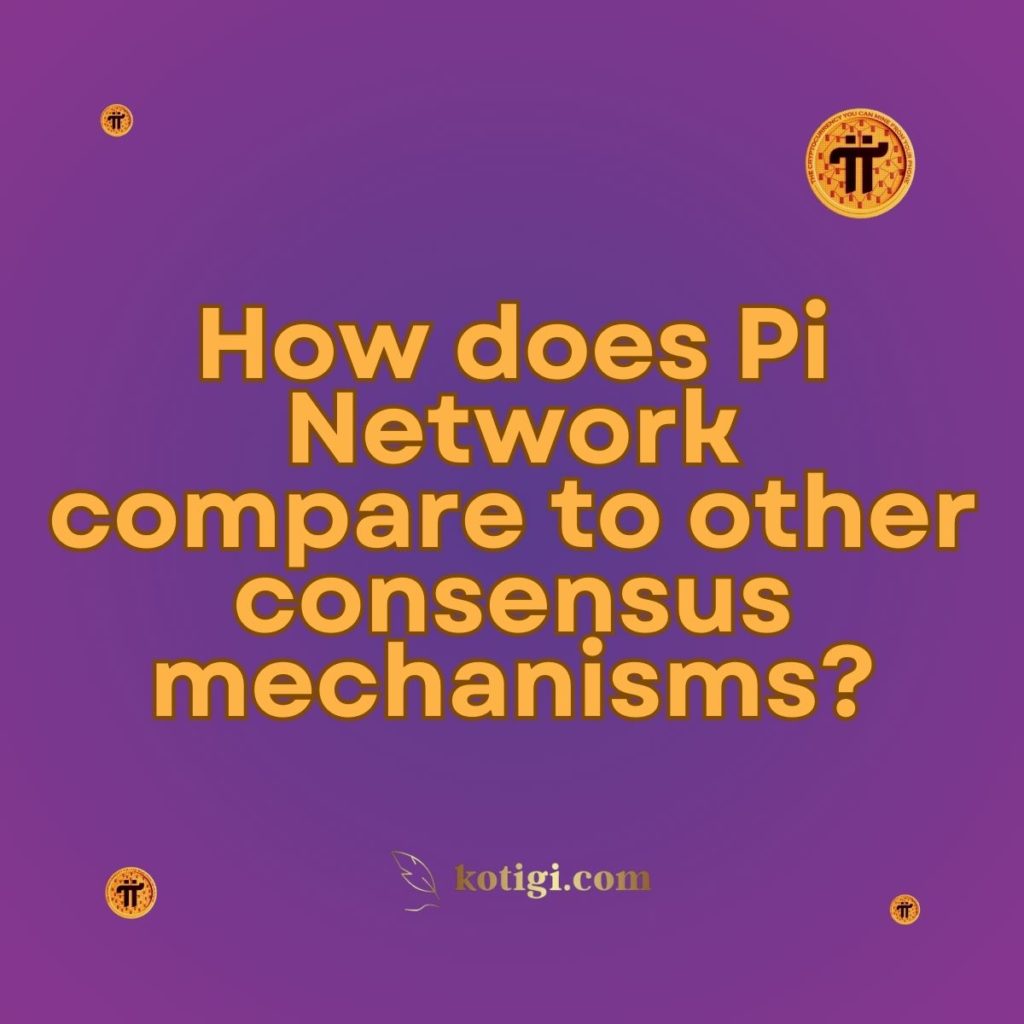
Here’s a more simplified version of the comparison table for Pi Network’s consensus mechanism (Stellar Consensus Protocol, SCP) versus other consensus mechanisms:
| Feature | Pi Network (SCP) | Proof of Work (PoW) | Proof of Stake (PoS) | Delegated Proof of Stake (DPoS) | PBFT | Hybrid Models |
|---|---|---|---|---|---|---|
| Type | Trust-based (SCP) | Mining | Staking | Voting by delegates | Node agreement | Mixed methods |
| Energy Use | Very Low | Very High | Low | Low | Low | Moderate |
| Decentralization | High | Moderate | Moderate | Moderate (few delegates) | Low | Varies |
| Scalability | High | Low | High | High | Moderate | Moderate to High |
| Security | High | Very High | High | Moderate | High | High |
| Governance | Community-based | Miner-controlled | Wealth-based | Delegate-controlled | Centralized | Varies |
| Entry Barriers | Low (easy access) | High (expensive mining) | Moderate (requires staking) | Moderate (needs staking) | High (requires permission) | Varies |
| Best For | Public, eco-friendly apps | High security, value transfer | Staking rewards, smart contracts | Fast transactions | Private networks | Multiple use cases |
Quick Takeaways:
- Energy Efficiency: Pi Network (SCP) is extremely low-energy compared to PoW.
- Decentralization: Pi Network has a high level of decentralization; PoW and PoS can become centralized.
- Scalability: Pi Network, PoS, and DPoS are highly scalable; PoW is less so.
- Security: All mechanisms provide good security, but Pi Network does so with low energy use.
- Accessibility: Pi Network is easily accessible to all users, unlike PoW and PoS, which have higher entry barriers.
How does Pi Network compare to other consensus mechanisms?
Pi Network employs a unique consensus mechanism to achieve decentralization, scalability, and security while maintaining low energy consumption. Unlike traditional blockchain networks like Bitcoin and Ethereum that rely on energy-intensive Proof of Work (PoW) or capital-intensive Proof of Stake (PoS), Pi Network uses a modified version of the Stellar Consensus Protocol (SCP). This approach offers several advantages and some trade-offs compared to other consensus mechanisms. Below is an in-depth comparison of Pi Network’s consensus model with other popular mechanisms.
1. Pi Network’s Consensus Mechanism: Stellar Consensus Protocol (SCP)
1.1 Overview of SCP
Pi Network is built on a modified version of the Stellar Consensus Protocol (SCP), which utilizes a Federated Byzantine Agreement (FBA) model. Unlike PoW or PoS, SCP does not rely on miners or validators staking capital. Instead, it relies on quorum slices—subsets of nodes that each node trusts. Consensus is achieved when enough quorum slices overlap, ensuring that the network is both secure and decentralized.
1.2 Key Advantages of SCP in Pi Network
- Energy Efficiency: Unlike PoW, which requires significant computational power and energy consumption, SCP is lightweight and can be run on low-powered devices, including mobile phones.
- Scalability: By reducing the computational overhead required to achieve consensus, SCP allows for faster transaction times and higher throughput.
- Decentralization through Trust Networks: Pi Network enhances SCP’s FBA model by incorporating Security Circles—trusted groups of users that help validate transactions and build trust in the network, reducing the risk of Sybil attacks.
2. Comparison with Proof of Work (PoW)
2.1 Overview of PoW
PoW is the consensus mechanism used by Bitcoin and was the first method developed for achieving consensus in blockchain networks. It requires miners to solve complex mathematical puzzles to validate transactions and add new blocks to the blockchain.
2.2 Pros and Cons of PoW Compared to Pi Network’s SCP
- Energy Consumption: PoW is highly energy-intensive, requiring specialized hardware (like ASICs) and large amounts of electricity. In contrast, SCP is energy-efficient and can run on standard devices, making it more accessible.
- Security: PoW is highly secure due to its computational complexity, making it difficult for malicious actors to take control of the network. However, SCP provides a different security model based on trust networks (Security Circles), which can be equally effective without the high energy costs.
- Decentralization: While PoW networks like Bitcoin are decentralized, mining power is often concentrated in large mining pools, leading to centralization risks. Pi Network’s SCP decentralizes control by enabling everyday users to participate in consensus, reducing concentration risks.
3. Comparison with Proof of Stake (PoS)
3.1 Overview of PoS
Proof of Stake (PoS) is used by Ethereum 2.0 and other blockchain networks like Cardano and Solana. In PoS, validators are chosen to propose and validate new blocks based on the amount of cryptocurrency they “stake” or lock up as collateral.
3.2 Pros and Cons of PoS Compared to Pi Network’s SCP
- Energy Efficiency: Both PoS and SCP are more energy-efficient than PoW. However, PoS can lead to a concentration of power among those who stake large amounts, whereas SCP relies on overlapping quorum slices for decentralized decision-making.
- Security and Centralization Risks: PoS may create a system where wealthier participants have more control, potentially leading to centralization. SCP avoids this issue by building trust-based consensus among diverse nodes, enhancing decentralization.
- Scalability: Both PoS and SCP offer scalability advantages. PoS networks can handle many transactions per second (TPS), but they often face challenges like validator collusion. SCP’s trust model prevents such collusion by involving trusted sub-networks for consensus.
4. Comparison with Delegated Proof of Stake (DPoS)
4.1 Overview of DPoS
Delegated Proof of Stake (DPoS) is used by networks like EOS and TRON. In DPoS, stakeholders vote for a small number of delegates who are responsible for validating transactions and securing the network.
4.2 Pros and Cons of DPoS Compared to Pi Network’s SCP
- Decentralization: While DPoS is more scalable than PoW and PoS, it often leads to centralization, as only a small group of delegates make decisions for the entire network. Pi Network’s SCP avoids this by not relying on elected delegates, instead using a more decentralized quorum-based approach.
- Governance: DPoS introduces a governance layer where delegates can vote on protocol changes. While this can be efficient, it often results in a concentration of power. Pi Network’s decentralized governance model aims to be more inclusive by engaging the entire community through its consensus process.
- Performance and Efficiency: DPoS is known for its high performance and efficiency, but this often comes at the cost of reduced decentralization. SCP maintains efficiency while balancing decentralization by distributing trust among diverse users.
5. Comparison with Practical Byzantine Fault Tolerance (PBFT)
5.1 Overview of PBFT
Practical Byzantine Fault Tolerance (PBFT) is used by some permissioned blockchain networks like Hyperledger Fabric. PBFT requires all nodes to agree on the order and validity of transactions, ensuring high consistency and fault tolerance.
5.2 Pros and Cons of PBFT Compared to Pi Network’s SCP
- Consensus Model: PBFT is effective in environments where nodes are known and trusted, making it ideal for private blockchains. In contrast, Pi Network’s SCP is designed for a more open environment with unknown nodes.
- Scalability and Performance: PBFT can be less scalable due to the need for extensive communication between nodes. SCP’s quorum-based model allows for better scalability and efficiency, particularly in open networks.
- Decentralization: PBFT networks are not highly decentralized as they require permissioned participants. Pi Network’s SCP provides a more decentralized model suitable for public blockchains by allowing trust-based consensus without needing explicit permission.
6. Comparison with Hybrid Consensus Models
6.1 Overview of Hybrid Models
Hybrid consensus models combine elements from multiple consensus mechanisms, such as PoW/PoS or PoW/PBFT, to balance security, scalability, and decentralization.
6.2 Pros and Cons of Hybrid Models Compared to Pi Network’s SCP
- Flexibility: Hybrid models offer flexibility by balancing the strengths and weaknesses of different consensus mechanisms. However, they often add complexity to the network architecture, which can be challenging to manage.
- Energy and Cost Efficiency: Hybrid models may still involve energy-intensive components (like PoW) or high entry barriers (like PoS), while SCP remains simple and low-cost by leveraging trust and community engagement.
- Decentralization and Security: While hybrid models aim to optimize decentralization and security, they can still be vulnerable to the centralization risks associated with their underlying mechanisms. SCP’s trust-based approach provides a simpler and more elegant solution to achieving secure decentralization.
Conclusion
Pi Network’s use of the Stellar Consensus Protocol (SCP) offers a unique blend of energy efficiency, scalability, and decentralization that distinguishes it from other consensus mechanisms like PoW, PoS, DPoS, PBFT, and hybrid models. By focusing on a community-driven approach that emphasizes trust, accessibility, and inclusivity, Pi Network addresses the limitations and challenges posed by traditional consensus mechanisms. As blockchain technology evolves, Pi Network’s SCP-based model could serve as a blueprint for other projects seeking a balance between decentralization, security, and efficiency.





